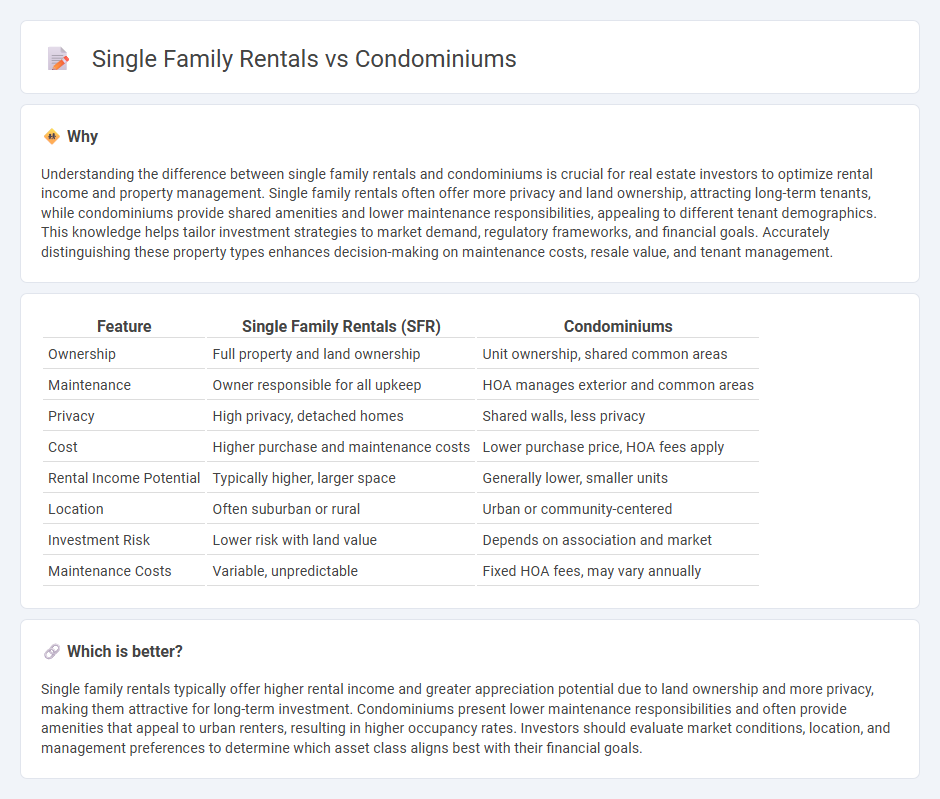
Single family rentals offer spacious living with private yards, appealing to tenants seeking more privacy and family-oriented amenities, while condominiums provide convenient maintenance and access to shared facilities, attracting urban dwellers and investors focusing on amenities and location. Market trends show single family rentals often yield higher long-term appreciation, whereas condos benefit from lower entry costs and easier liquidity. Discover detailed comparisons and investment insights to choose the best option for your real estate portfolio.
Why it is important
Understanding the difference between single family rentals and condominiums is crucial for real estate investors to optimize rental income and property management. Single family rentals often offer more privacy and land ownership, attracting long-term tenants, while condominiums provide shared amenities and lower maintenance responsibilities, appealing to different tenant demographics. This knowledge helps tailor investment strategies to market demand, regulatory frameworks, and financial goals. Accurately distinguishing these property types enhances decision-making on maintenance costs, resale value, and tenant management.
Comparison Table
| Feature | Single Family Rentals (SFR) | Condominiums |
|---|---|---|
| Ownership | Full property and land ownership | Unit ownership, shared common areas |
| Maintenance | Owner responsible for all upkeep | HOA manages exterior and common areas |
| Privacy | High privacy, detached homes | Shared walls, less privacy |
| Cost | Higher purchase and maintenance costs | Lower purchase price, HOA fees apply |
| Rental Income Potential | Typically higher, larger space | Generally lower, smaller units |
| Location | Often suburban or rural | Urban or community-centered |
| Investment Risk | Lower risk with land value | Depends on association and market |
| Maintenance Costs | Variable, unpredictable | Fixed HOA fees, may vary annually |
Which is better?
Single family rentals typically offer higher rental income and greater appreciation potential due to land ownership and more privacy, making them attractive for long-term investment. Condominiums present lower maintenance responsibilities and often provide amenities that appeal to urban renters, resulting in higher occupancy rates. Investors should evaluate market conditions, location, and management preferences to determine which asset class aligns best with their financial goals.
Connection
Single family rentals and condominiums both serve as popular housing options within the real estate market, attracting different types of investors and tenants based on ownership structure and lifestyle preferences. Single family rentals offer detached homes typically favored for privacy and yard space, while condominiums provide shared amenities and maintenance benefits, appealing to those seeking convenience and community living. The interplay between these property types influences urban housing trends, rental market dynamics, and investment strategies across diverse geographic regions.
Key Terms
Homeowners Association (HOA)
Condominiums typically involve Homeowners Association (HOA) fees that cover maintenance, amenities, and shared services, impacting overall rental costs and management responsibilities. Single-family rentals usually lack HOA fees but may require tenants or owners to handle all property upkeep independently. Explore detailed comparisons on HOA implications to make informed investment decisions.
Fee Simple Ownership
Fee simple ownership grants condominium owners full control over their individual units, along with a shared interest in common areas, distinguishing it from single family rentals where tenants hold no ownership rights. Condominiums often involve monthly homeowners association (HOA) fees covering maintenance and amenities, impacting overall investment costs compared to single family rentals which typically have direct landlord-tenant arrangements. Explore the detailed benefits and considerations of fee simple ownership in condominiums versus single family rentals to make informed real estate decisions.
Shared Amenities
Condominiums typically offer shared amenities such as swimming pools, fitness centers, and common lounges that enhance community living and provide added value for renters. Single family rentals usually lack these shared spaces, offering more privacy but with fewer communal features. Explore the benefits of shared amenities in condominiums to determine the best rental option for your lifestyle.
Source and External Links
What is a condo? Condominiums defined - A condominium (condo) is a residential complex where individuals own separate units and share ownership and maintenance responsibility for common areas through a condominium owners association or HOA.
condominium | Wex | US Law | LII / Legal Information Institute - Condominiums are common interest developments in which each owner holds title to their unit and is a member of the governing association that manages shared areas and enforces rules.
What Is A Condo? Pros And Cons For Homebuyers - A condo is an individually owned residential unit within a community, where owners jointly own shared spaces and follow rules set by a homeowners association, providing less maintenance than single-family homes.
 dowidth.com
dowidth.com